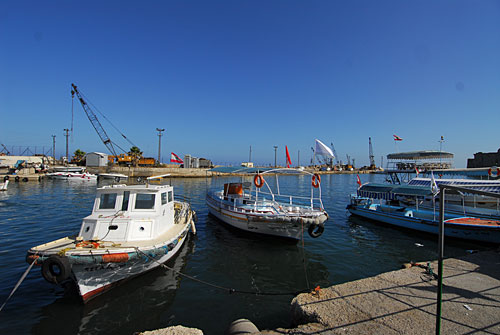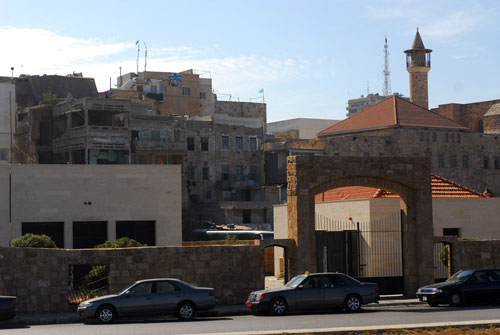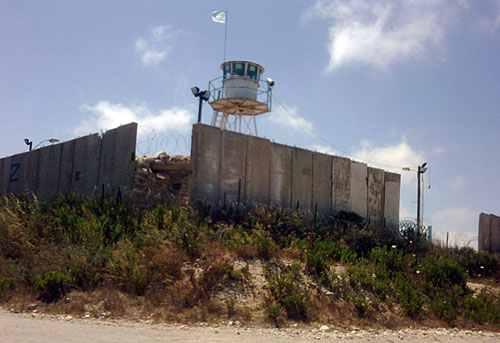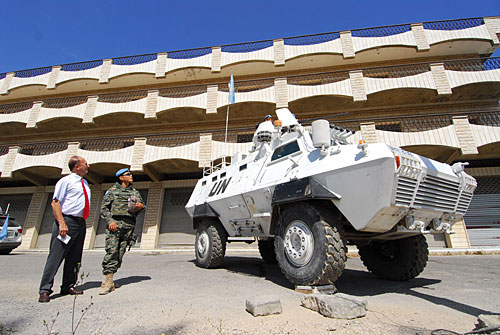2009 Lebanon Parliamentary Elections - Deborah Hakes Blogs
From Carter Center Election Observation Mission
Today, I headed south to Lebanon's border with Hrair Balian, the director of the Conflict Resolution Program at The Carter Center, to be briefed by the United Nations Interim Forces in Lebanon (UNIFIL), and to see what the pre-election environment was like there.
 Photos: D.Hakes/The Carter Center
Photos: D.Hakes/The Carter Center
Schoolchildren from the neighboring area painted artwork relating to peace in Lebanon on some of the walls of the UNIFIL in Naquoura, Lebanon.
We passed through Sidon, an ancient seaside city of around 200,000 people. (Read the interesting Wall Street Journal story on Sidon's fishermen and the upcoming elections.)
 Boats in Sidon, Lebanon, south of Beirut.
Boats in Sidon, Lebanon, south of Beirut.
 Much has been rebuilt in Lebanon's south since the 2006 war with Israel, but damage remains. Note the condition of the building on the left.
Much has been rebuilt in Lebanon's south since the 2006 war with Israel, but damage remains. Note the condition of the building on the left.
Orange groves and banana plantations lined the road further south, and soon we reached our ultimate destination of Naqoura, site of UNIFIL's headquarters in Lebanon.
 The United Nations post in Naquoura, Lebanon.
The United Nations post in Naquoura, Lebanon.
While the election is all but decided there – the population is overwhelmingly Shia Muslim who support Hezbollah and Amal candidates, both members of the March 8 coalition – peacekeepers told us that the situation is very tense because of developments not related to the election. In fact, we were not allowed to take an overview tour of the area by helicopter as originally planned.
Instead UNIFIL took us to see the "blue line," which marks the border with Israel just three kilometers from its headquarters.
 United Nations barrels mark the "blue line," signifying the border between Lebanon and Israel.
United Nations barrels mark the "blue line," signifying the border between Lebanon and Israel.
The drive up the dusty hills of Naqoura to the blue line took around 10 minutes. Before leaving, we were given blue flak jackets, just in case, and then were on our way, escorted by U.N. vehicles flashing their lights.
Just to the side of the road was a wire fence and red signs with skull and crossbones, warning of land mines. The U.N. told us many land mines and cluster bombs left behind by Israel in 2006 remain in the ground. It's difficult work to clear them because of thick brush, rough terrain, and their hidden locations.
Finally, we stood on top of the hill overlooking Israel. What a beautiful view to see the Mediterranean Sea, mountains, and cities in the distance. Not so beautiful were the wire fences and cement barriers up close.
Sunday's elections here in Lebanon are inevitably tied to this border and to the many complicated issues caused by the ongoing Arab-Israeli conflict in general.
 Hrair Balian, director of the Carter Center's Conflict Resolution Program, talks with U.N. peacekeepers in south Lebanon.
Hrair Balian, director of the Carter Center's Conflict Resolution Program, talks with U.N. peacekeepers in south Lebanon.
President Carter visited Naqoura in December 2008 and was able to take the helicopter tour. Reflections from his trip report are below:
"We spent one day visiting the UNIFIL area south of the Litani River. We flew by helicopter along the coast past Tyre and Sidon, then landed at Naqoura just north of the Israeli border. We then traveled along the "blue line" between Israel and Lebanon and viewed the distant Sea of Galilee from the helicopter while proceeding eastward toward Mount Hermon. Italian general Graziano was our host, and we landed at various key posts to visit the troops from different nations. At one site near the border, two different Israeli tanks came about 70 yards from us to observe our group.
"A surprise for me was that Shebaa Farms was just a bare hillside on the southwest slope of the mountain, with no permanent occupants, no real cultivation, and only some sheep herders who went back and forth between the Israeli occupied area and north into Lebanon to obtain water. Israelis are also occupying the northern (Lebanese) 2/3 of a small village named Garjaa. The general showed us a graph of the many flights of Israeli planes over all parts of Lebanon, averaging about a dozen each day. Neither Hezbollah nor the Lebanese Armed Forces have any anti-aircraft weapons for defense."
< Read previous blog Read next blog >
Deborah Hakes will blog daily from the Lebanon elections through June 10.